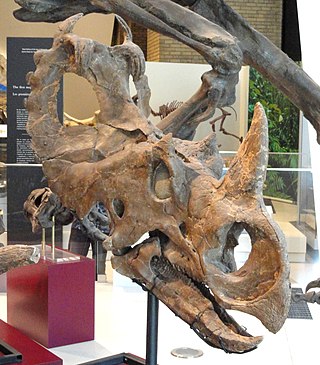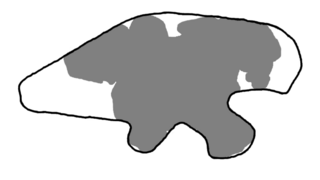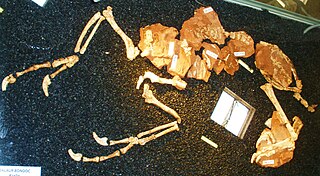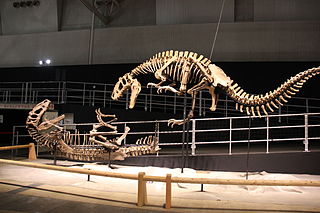
Stenonychosaurus is a genus of troodontid dinosaur from the Late Cretaceous Dinosaur Park Formation of Alberta, Canada, as well as possibly the Two Medicine Formation. The type and only species, S. inequalis, was named by Charles Mortram Sternberg in 1932, based on a foot, fragments of a hand, and some caudal vertebrae from the Late Cretaceous of Alberta. S. inequalis was reassigned in 1987 by Phil Currie to the genus Troodon, which was reverted by the recognition of Stenonychosaurus as a separate genus from the possibly dubious Troodon in 2017 by Evans et al. and also later in the same year by Van der Reest and Currie.

Gregory Scott Paul is an American freelance researcher, author and illustrator who works in paleontology. He is best known for his work and research on theropod dinosaurs and his detailed illustrations, both live and skeletal. Professionally investigating and restoring dinosaurs for three decades, Paul received an on-screen credit as dinosaur specialist on Jurassic Park and Discovery Channel's When Dinosaurs Roamed America and Dinosaur Planet. He is the author and illustrator of Predatory Dinosaurs of the World (1988), The Complete Illustrated Guide to Dinosaur Skeletons (1996), Dinosaurs of the Air (2001), three editions of The Princeton Field Guide to Dinosaurs, Gregory S. Paul's Dinosaur Coffee Table Book (2010), The Princeton Field Guide to Pterosaurs (2022), The Princeton Field Guide to Mesozoic Sea Reptiles (2022) and editor of The Scientific American Book of Dinosaurs (2000).

Styracosaurus is an extinct genus of herbivorous ceratopsian dinosaur from the Late Cretaceous of North America. It had four to six long parietal spikes extending from its neck frill, a smaller jugal horn on each of its cheeks, and a single horn protruding from its nose, which may have been up to 60 centimeters long and 15 centimeters wide. The function or functions of the horns and frills have been debated for many years.

Centrosaurus is a genus of centrosaurine ceratopsian dinosaur from Campanian age of Late Cretaceous Canada. Their remains have been found in the Dinosaur Park Formation, dating from 76.5 to 75.5 million years ago.

Ornitholestes is a small theropod dinosaur of the late Jurassic of Western Laurasia.

Antarctosaurus is a genus of titanosaurian sauropod dinosaur from the Late Cretaceous Period of what is now South America. The type species, Antarctosaurus wichmannianus, and a second species, Antarctosaurus giganteus, were described by prolific German paleontologist Friedrich von Huene in 1929. Three additional species of Antarctosaurus have been named since then but later studies have considered them dubious or unlikely to pertain to the genus.

Neovenator is a genus of carcharodontosaurian theropod dinosaur. It is known from several skeletons found in the Early Cretaceous (Hauterivian-Barremian) Wessex Formation on the south coast of the Isle of Wight, southern England. It is one of the best known theropod dinosaurs from the Early Cretaceous of Europe.

Mirischia is a small genus of compsognathid theropod dinosaur from the Albian stage of Brazil.

Metriacanthosaurus is a genus of metriacanthosaurid dinosaur from the upper Oxford Clay of England, dating to the Late Jurassic period, about 160 million years ago.

Monoclonius is an extinct genus of herbivorous ceratopsian dinosaur found in the Late Cretaceous layers of the Judith River Formation in Montana, United States, and the uppermost rock layers of the Dinosaur Park Formation in Alberta, Canada dated to between 75 and 74.6 million years ago.

Stephen Louis Brusatte FRSE is an American paleontologist and evolutionary biologist who specializes in the anatomy and evolution of dinosaurs. He was educated at the University of Chicago for his Bachelor's degree, at the University of Bristol for his Master's of Science on a Marshall Scholarship, and finally at the Columbia University for Master's in Philosophy and Doctorate. He is currently Professor of Palaeontology and Evolution at the University of Edinburgh. In April 2024, Brusatte was elected to fellowship of the Royal Society of Edinburgh.

The dinosaur renaissance was a highly specified scientific revolution that began in the late 1960s and led to renewed academic and popular interest in dinosaurs. It was initially spurred on by research indicating that dinosaurs may have been active warm-blooded animals, rather than sluggish cold-blooded lizard-like reptilians as had been the prevailing view and description during the first half of the twentieth century.

Tyrannosaurinae is one of the two extinct subfamilies of Tyrannosauridae, a family of coelurosaurian theropods that consists of at least three tribes and several genera. All fossils of these genera have been found in the Late Cretaceous deposits of western North America and east Asia. Compared to the related subfamily Albertosaurinae, tyrannosaurines overall are more robust and larger though the alioramins were gracile by comparison. This subfamily also includes the oldest known tyrannosaurid genus Lythronax as well as the youngest and most famous member of the group, Tyrannosaurus rex. There were at least 30 different species of tyrannosaurines.

Paleoart is any original artistic work that attempts to depict prehistoric life according to scientific evidence. Works of paleoart may be representations of fossil remains or imagined depictions of the living creatures and their ecosystems. While paleoart is typically defined as being scientifically informed, it is often the basis of depictions of prehistoric animals in popular culture, which in turn influences public perception of and fuels interest in these animals. The word paleoart is also used in an informal sense, as a name for prehistoric art, most often cave paintings.

Xiongguanlong is an extinct genus of tyrannosauroid theropod from the Early Cretaceous period of what is now China. The type and only species is X. baimoensis. The generic name comes from Jiayuguan City and the Mandarin word "long" which means dragon. The specific epithet, "baimoensis" is a latinization of the Mandarin word for "white ghost" in reference to one of the geological features of the type locality.

Balaur is a genus of theropod dinosaur from the late Cretaceous period, in what is now Romania. It is the type species of the monotypic genus Balaur, after the balaur, a dragon of Romanian folklore. The specific name bondoc means "stocky", so Balaur bondoc means "stocky dragon" in Romanian. This name refers to the greater musculature that Balaur had compared to its relatives. The genus, which was first described by scientists in August 2010, is known from two partial skeletons.

Juratyrant is a tyrannosauroid dinosaur genus from the late Jurassic period of England. The genus contains a single species, Juratyrant langhami, which was once classed as a species of Stokesosaurus.

Yutyrannus is a genus of proceratosaurid tyrannosauroid dinosaur which contains a single known species, Yutyrannus huali. This species lived during the early Cretaceous period in what is now northeastern China. Three fossils of Yutyrannus huali —all found in the rock beds of Liaoning Province— are currently the largest-known carnivorous dinosaur specimens that preserve direct evidence of feathers.

All Yesterdays: Unique and Speculative Views of Dinosaurs and Other Prehistoric Animals is a 2012 art book on the palaeoartistic reconstruction of dinosaurs and other extinct animals by John Conway, C. M. Kosemen and Darren Naish. A central tenet of the book concerns the fact that many dinosaur reconstructions are outdated, overly conservative, and inconsistent with the variation observed in modern animals. This focus is communicated through an exploration of views of dinosaurs and related animals that are unusual and sometimes even confusing to viewers, but which are well within the bounds of behaviour, anatomy and soft tissue that we see in living animals.

Aurornis is an extinct genus of anchiornithid theropod dinosaurs from the Jurassic period of China. The genus Aurornis contains a single known species, Aurornis xui. Aurornis xui may be the most basal ("primitive") avialan dinosaur known to date, and it is one of the earliest avialans found to date. The fossil evidence for the animal pre-dates that of Archaeopteryx lithographica, often considered the earliest bird species, by about 10 million years.




















